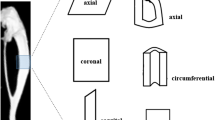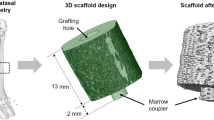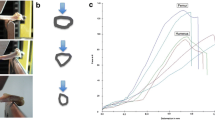Abstract
Introduction
The biological function of the periosteum is profusely described but its contribution to the biomechanical properties of the bone has been considered negligible. The purpose of this study was to examine the biomechanical properties of periosteum-preserved long bones.
Materials and methods
The biomechanical properties of both femora and tibiae of 30 male, 4-month-old Wistar rats were evaluated using a destructive three-point-bending testing protocol. In both bones from one side the periosteum was preserved, while in the contralateral bones the periosteum was stripped off. Ultimate strength, stiffness, energy absorption and deflection were derived automatically from the load-deformation curve recorded for each bone.
Results
As regards the femur, the periosteum-covered bones displayed statistically significant higher values for all parameters measured compared to the periosteum-stripped bones. Ultimate strength, stiffness, absorbed energy and deflection of stripped and periosteum-covered femora were, respectively, 146.76 ± 44.71 and 196.01 ± 41.47 N, 44.25 ± 17.35 and 61.62 ± 15.07 N/mm, 0.00054 ± 0.00274 and 0.00011 ± 0.00354 Nmm, 0.67 ± 0.25 and 1.07 ± 0.28 mm. In the tibia, only energy absorption (0.00353 ± 0.00199 and 0.0010 ± 0.00339 Nmm) and deflection (1.71 ± 0.56 and 0.86 ± 0.36 mm) were significantly higher in the periosteum-covered bones. The pattern of bone failure was also different in the two groups. In periosteum-covered bones the two bone parts remained in close apposition stabilized by the periosteal membrane, while in a few cases the periosteum was stretched or torn opposite the loading site.
Conclusion
The periosteum not only has significant biological function but also provides mechanical support to the bone and amplifies the biomechanical capacity of intact rat long bones in bending, probably taking advantage of its fibrous and elastic properties.
Similar content being viewed by others
Avoid common mistakes on your manuscript.
Introduction
The periosteal membrane or periosteum is a layered structure consisting of dense fibrous connective tissue, which encloses the external surface of many bones. The periosteum forms a continuous composite fibroelastic membrane that envelopes the bone to which it is intimately attached, especially at the metaphyseal regions. It has an important function in bone healing and bone remodelling throughout life [1, 4] but its biomechanical role is only rarely addressed and is generally perceived as being not significant [1, 5, 7].
The stress–strain relationship and the tensile strength of the periosteum have been evaluated in a limited number of studies showing a curvilinear pattern, similar to other soft tissues, e.g. the ligaments or the skin [3]. The effect of periosteum preservation on the biomechanical properties of intact long bones has been sporadically evaluated [2, 3] but these studies failed to prove a considerable biomechanical role of the periosteum, because of several study design obstacles regarding the methodology or the quality of the bone specimens used.
In the present study we investigated whether preservation of the periosteum affects the biomechanical properties of intact long bones using the bones from both hindlimbs of the rat. Comparison between the bones harvested from both hindlimbs is justified because their mechanical properties do not differ significantly, at least in young, healthy animals [6].
Materials and methods
In this study, 40 male, 4–6 month old Wistar rats were used, and the experimental protocol was approved by the Athens Veterinary Directorate, in compliance with the EEC Directive 609/86. With a power analysis of pilot data a sample size of 7 was calculated. With this sample size and the probability of type I error set at α = 0.05, the probability of a type II error was β = 0.18. The mean weight of the animals subjected to biomechanical testing was 344 ± 39 g. Following ether euthanasia, both hindlimb bones (femora and tibiae) were harvested and disarticulated at the hip, knee and ankle joints. The contralateral bones were randomly allocated either to a periosteum-preserving or to a periosteum-stripped group. As a result, four groups of bones were established: femur and tibia with periosteum (Groups A and B) and femur and tibia without periosteum (Groups C and D), including 40 bones each. There was no muscle or tendon insertion in the examined area because of the influence on the periosteal thickness and the underlying bone shape. The external dimensions of the femora and the tibiae at the point of loading were measured with a digital caliper. The biomechanical properties were evaluated employing a destructive three-point-bending test using a materials testing machine (Karl Frank GmBH, Germany) within 3 h after killing the animal in order to eliminate any bias imposed by the preservation and storage methods. The distance between the two supporting bars was 20 mm, and the load was applied by means of a third bar at the middle of the lateral surface of the femur and at the middle of the posterior surface of the tibia. Preloading of 15 N was applied and the loading rate was 15 cm/min. The deformation measurement was set to zero at the preload value. Ultimate strength, stiffness, absorbed energy and deflection were automatically calculated from the load-deflection curve. The results were analysed statistically using the paired t-test and the significance level was set to P = 0.05. All data are presented as mean ± standard deviation.
Results
The external dimensions of the femora and the tibiae at the point of loading did not differ between the contralateral bones. In the femur, the ultimate strength, stiffness, absorbed energy and deflection of the stripped and the periosteum-covered femora were, respectively, 146.76 ± 44.71 and 196.01 ± 41.47 N, 44.25 ± 17.35 and 61.62 ± 15.07 N/mm, 0.00054 ± 0.00274 and 0.00011 ± 0.00354 Nmm, 0.67 ± 0.25 and 1.07 ± 0.28 mm. All differences were statistically significant (P < 0.001). In the tibia, the ultimate strength, stiffness, absorbed energy and deflection for the stripped and the periosteum-covered tibiae were, respectively, 73.86 ± 34.85 and 90.60 ± 27.67 N, 24.62 ± 11.61 and 30.19 ± 9.22 N/mm, 0.00353 ± 0.00199 and 0.0010 ± 0.00339 Nmm and 0.86 ± 0.36 and 1.71 ± 0.56 mm. The differences in ultimate strength and stiffness were not statistically significant (P = 0.179), while energy absorption and deflection values were statistically significant (P = 0.016 and P = 0.027, respectively). All data are graphically presented in Fig. 1. There was no pair of bones where the ultimate strength was higher in the stripped bone compared with the periosteum-covered bone. Regarding the mode of failure, following bone fracture the periosteum remained intact in the majority of the bones, and the fractured bone ends remained in apposition compared to the periosteum-stripped bones. The fractured bone ends remained within the periosteal membrane (Fig. 2). In six cases the periosteum was stretched or torn opposite the loading site, while no periosteal avulsion or failure at the metaphysis was noted.
Discussion
The purpose of this study was to examine the effect of periosteum on the biomechanical properties of the long bone. It was shown that preservation of the periosteum in the rat femur and tibia improved their biomechanical properties.
The contribution of the periosteum in the mechanical properties of intact long bones was evaluated in a few studies. Huller and Nathan [4] examined the mechanical contribution of the periosteum using adult dog ribs and adult rabbit long bones. The bones were loaded at 3 cm/min in three-point-bending but the distance between the supporting bars was variable. In the rabbit long bones a not statistically significant tendency towards increased breaking force and absorbed energy was observed, while in dog ribs no difference was noted. Kitaoka et al. [5] examined the mechanical contribution of the periosteum in four-point-bending using adult goat ribs but the direction of loading is not reported. The maximum load was higher but not statistically significant in the periosteum-covered ribs, while maximal deformation and absorbed energy were significantly higher, 25.2 and 24.0%, respectively.
The anatomical and mechanical coupling provided by the periosteum in long bones is more substantial in the immature skeleton, where the thickness of the periosteum is increased compared with adult bones [4]. In the rabbit radius, preservation of the periosteum in the epiphyseal–metaphyseal junction increases the resistance of the growth plate to shearing forces, and this contribution is exaggerated in younger animals [2]. An age-related maturation process of the periosteal mechanical properties has been also described [3].
Bertram et al. [1] examined the mechanical properties of avian periosteum using chick Leghorn tibiotarsi bones. The stress–strain curve derived from this experiment was non-linear showing a biphasic pattern with an initial low stiffness area followed by a high stiffness area at higher strain values. The low stiffness region was two orders of magnitude less stiff than the high stiffness region for loading to a level below the in vivo observed, a finding typical of collagen-based biomaterials. In the high stiffness region the collagen fibres straighten, while in the low-stiffness region they retain a wavy appearance. Τhe periosteum from the bovine tibia shows a distinctive stress–strain pattern, similar to those exhibited by ligaments and tendons [8]. The periosteum interfacing with ligaments or muscles exhibits greater stiffness and strength compared with the periosteum with no ligament attachment [2]. In our study all muscles had been removed to isolate the periosteum because muscle attachment to periosteum influences its mechanical properties.
Loading rate is an important issue in bone strength. A low loading rate probably does not bring out the elastic properties of the periosteum compared to a relatively high loading rate. Huller and Nathan [4] tested rabbit femora and canine ribs at 3 cm/min, while Kitaoka et al. [5] tested adult goat ribs at a rate of 30 cm/min. Ribs are non-weight bearing bones; their shape is irregular, their dimensions vary, have primarily a protective function and serve for muscle attachment. Reflecting their function the mechanical properties of the periosteum in the ribs may be less well developed.
In the present study, the mechanical contribution of the periosteum was profound in the rat femur, increasing its biomechanical properties. In the tibia only the deflection and the absorbed energy were affected, while the breaking strength and stiffness were unaffected. These findings are similar to those observed in goat ribs presented by Kitaoka et al. [5] and may probably be attributed to the loading direction e.g. posteroanteriorly. The tibial periosteum is thicker at its posterior surface, where the muscles of the posterior compartment attach, but is thinner at the anteromedial and anterolateral surface where no or a limited muscle attachment occurs. Probably, if the tibia was loaded in the anteroposterior direction placing the thicker posterior periosteum under tension its mechanical performance would be exaggerated. The outer layer of the periosteum, which consists of dense fibrous tissue, probably increases the resistance of the intact bone to the tensile forces imposed by the three-point bending. Bones are weaker in tension than compression and in bending failure occur predominately on the side of the bone loaded in tension. When a bone is tested in bending the near cortex is compressed, the far cortex fails in tension and the periosteum is stretched, taking advantage of the tensile properties of collagen and elastic fibres of its outer layer (Fig. 3). The magnitude of this effect on the mechanical properties of the bone is probably loading rate-dependent. The adhesion of the periosteum is minimal at the diaphysis but is considerable at the metaphyses [3]. In the present study the periosteum was stretched and detached at the mid-diaphysis but the metaphyseal attachment was preserved, while periosteal ruptures were uncommon.
The mechanism with which the periosteum improves the biomechanical properties of the femur. In resting condition the periosteum fibres (solid black line) are relatively lax (a), while in bending they progressively stretch (b). Following bone failure the periosteal membrane keeps the bone ends in relative apposition (c)
Our study has however several limitations. Only one animal species was examined using two bones loaded in one direction with a pretty high loading rate. The effect of periosteum preservation has to be examined comparing several loading configurations and loading rates. The effect of age-related periosteum alterations should also be examined using rats of young and advanced age. The difference between different animals or between the rat and the humans, regarding the thickness of periosteum in relation to the thickness of the cortices (or diaphysis diameter) has also to be examined. The thickness of the periosteum layer is not homogeneously thick, especially in the tibia implying that there is a significant influence depending on the direction of the load.
In conclusion, the periosteum covering the long bones may, under certain biological and loading conditions, increase the biomechanical capacity of the bone.
References
Bertram JEA, Polevoy Y, Cullinane DM (1998) Mechanics of avian fibrous periosteum: tensile and adhesion properties during growth. Bone 22:669–675
Deppermann F, Dallek M, Meenen N, Lorke D, Jungbluth KH (1989) The biomechanical significance of the periosteum for the epiphyseal groove. Unfallchirurgie 15:165–173
Eyre-Brook AL (1984) The periosteum: its function reassessed. Clin Orthop 189:300–307
Huller T, Nathan H (1970) Does the periosteum contribute to bone strength? Isr J Med Sci 6:630–634
Kitaoka K, Furman B, Saha S (1998) Periosteum: its biomechanical role in bone fracture. In: Proceedings of the North American Conference on Biomechanics (NACOB III), Waterloo, Canada, pp 501–502
Lin PP, Schupak KD, Boland PJ, Brennan MF, Healey JH (1998) Pathologic femoral fracture after periosteal excision and radiation for the treatment of soft tissue sarcoma. Cancer 82:2356–2365
Popowics TE, Zhu Z, Herring SW (2002) Mechanical properties of the periosteum in the pig Sus scrofa. Arch Oral Biol 47:733–41
Uchiyama E, Yamakoshi K, Sasaki T (1998) Measurement of mechanical characteristics of tibial periosteum and evaluation of local differences. J Biomech Eng 120:85–91
Author information
Authors and Affiliations
Corresponding author
Rights and permissions
About this article
Cite this article
Yiannakopoulos, C.K., Kanellopoulos, A.D., Trovas, G.P. et al. The biomechanical capacity of the periosteum in intact long bones. Arch Orthop Trauma Surg 128, 117–120 (2008). https://doi.org/10.1007/s00402-007-0433-5
Received:
Published:
Issue Date:
DOI: https://doi.org/10.1007/s00402-007-0433-5







